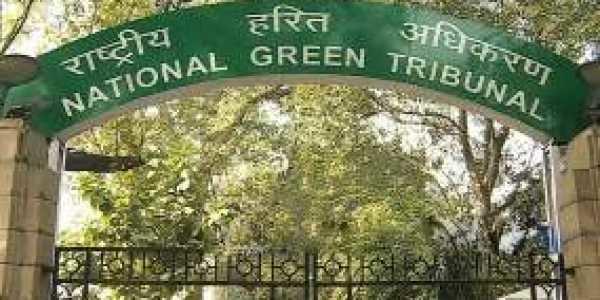Government Divides 900 Km Long Chardham Project Into 52 Parts to Bypass Environmental Clearances

Image Coutesy: The New Indian Express
The Government of India’s ongoing Chardham Mahamarg Vikas Pariyojna (Chardham project) in the hilly state of Uttarakhand – to connect the four pilgrimage sites of Yamunotri, Gangotri, Kedarnath and Badrinath – is mired in controversy with environmentalists alleging that it is in complete violation of the Forest (Conservation) Act, 1980 and the Environment Impact Assesment Notification, 2006. The matter has reached the National Green Tribunal (NGT), which has reserved its final order on the project.
This Chardham project entails road widening of approximately 900 km of the National Highways, which mainly connect the Chardham route. The Chardham of Uttarakhand – Yamunotri, Gangotri, Kedarnath and Badrinath – are places of immense cultural significance in India, as thousands of pilgrims travel to these holy shrines every year between the months of May and October for ‘darshan’. Situated along the banks of Yamuna, Bhagirathi, Mandakini and Alaknanda respectively, the four holy shrines are located in critically fragile and significant environmental areas of the Ganga – Himalayan basin.
In an alleged deliberate act of violation of legal provision, the project proponents have fragmented the stretch of 900 km into various small stretches. Initially, the whole project was divided into 14 linear stretches, but later it was further divided into as many as 52 small stretches. Each stretch is of less than 100 km. This has allegedly been done so that they can avoid going through the rigors of the Environment Impact Assesment Notification, 2006.
But in reality, it is a 900 km-long road and it is the cumulative impact this length – not 52 parts separately – that should be taken into consideration for environmental clearance.
“Not only they have violated the EIA Notification, 2006 through the illegal method of fragmentation/division of 900 km, but they have also violated the process and procedure for obtaining forest clearance. The government has taken forest clearance only for a particular stretch of a forest area on the National Highways. So the focus of the Forest Advisory Committee and other experts is only on that particular fragment (stretch of the highway) and on the comparatively less number of trees that will be cut in that fragment. The concerned authorities and experts have therefore not considered the cumulative impact of destruction of trees, slope cutting, destruction of catchment area etc. which will be huge,” said petitioner Hemant Dhyani of Ganga Avahan, an NGO working for the fragile ecosystem in the hill state.
The project—he said—has already commenced and resulted in cutting of around 25,303 trees over a combined stretch of 356 km of forest land. “In addition to cutting thousands of trees, hills are being cut for road widening. It is endangering the valleys and can most certainly lead to landslides,” he said.
The work on the remaining 544 km of the Chardham project – involving cutting of trees on forest land and cutting of slopes for widening – is yet to commence.
It has been alleged that neither the specifications of this Chardham project have been put in the public domain, nor have been elaborated upon through news or advertisements given in the media or through the information on internet. Vague, insufficient information of the project has been provided in the official press release dated December 23, 2016, by the Press Information Bureau (PIB), stating that, “the project aims at improving the connectivity of the Char Dham pilgrimage centres in the Himalayas, making journey to these centres safer, faster and more convenient”.
The Chardham project was advertised by the Modi government and the state government by the name of ‘Char Dham Mahamarg Vikas Pariyojna’, but a project with this name is nowhere to be found on the official website of the Ministry of Road Transport and Highways.
Facts related to Chardham project
No document related to official clearance in the name of ‘Chardham Mahamarg Vikas Pariyojna’ is available on the official website of the Ministry of Environment and Forests and Climate Change. Furthermore, there is no point of contact with regards to this Chardham project like details of responsible officials or correspondence addresses in the public domain.
What is visible on the ground is that this project entails blanket widening of existing Chardham project roads of 900 km passing through four districts namely Uttarkashi, Tehri, Rudraprayag and Chamoli. This entire Chardham project area falls in the catchment of Ganga-Bhagirathi, Yamuna, Alaknanda and Mandakini river valleys where the widening up to 12-24 metre requires cutting of thousands of tress, excavation of hills, dumping of muck, blasting of rocks and movement of heavy machineries in the highly sensitive terrain of Himalayas.
There was no information published for any Environmental Impact Assesment (EIA) regarding this project. It is nowhere found in the public domain whether the EIA of this massive project which costs approximately Rs 12,000 crores was conducted or not. The petitioner came to know about the execution of this project after large-scale cutting of the trees on the different segments of this Chardham route (Rishikesh to Gangotri, Dharasu to Yamunotri, Rishikesh to Kedarnath and Badrinath) began in December 2017.
It is pertinent to mention that these Stage I & II forest clearance approvals have been granted segment-wise. The number of trees to be cut is not declared for the entire project.
Forest clearances have been applied for in different segments, which fall under Chardham route and there was no declaration of the name of actual project which was advertised publicly in the name of ‘Chardham Mahamarg Vikas Pariyojna’.
“Through this technical manipulation and subterfuge by dividing this massive project into unrelated segments, the government is not only causing the massive damage to the sensitive ecology of this disaster-prone terrain, but is actually institutionalising corruption in the system through such practices,” said Dhyani.
All the 25,303 trees – involved in the Stage I & II forest clearance approvals – have already been cut starting from December 2017 to January 2018.
Vulnerability
From the vulnerability viewpoint, the Ganga-Himalayan basin is considered highly susceptible to climatic change. It has been observed and accepted that the Himalayan eco-system is facing grave risks owing to increasing global temperatures.
Natural disasters like the glacial lake outburst, flash floods, cloud burst, land-sinking, land sliding, earthquakes have been witnessed many a times in the past and the intensity and frequency of these events is only increasing.
Among all the North Indian Himalayan states, Uttarakhand is has the highest number of landslide-prone/unstable zones. The entire Chardham route falls under Seismic Zone IV and V, and has witnessed many earthquakes in the past; some have been severely devastative. Cloudbursts and subsequent flash floods are a common phenomenon in the Himalayan states.
In the later part of the last millennium, the state witnessed massive flash flood incident of 1978 in Bhagirathi valley, earthquakes of Chamoli and Uttrakashi of 1998 and 1991 respectively. The new millennium, however in just 17 years, has already documented several incidents of disasters in the area. Massive land sliding incidents like Varunavat tragedy of 2005, Bhatwadi land-sinking incident of 2010, Pitthoragarh landslide tragedy of 2016 and severe flash flood incidents of 2004, 2012, 2013. Even in the otherwise comparatively stable, lower altitude areas like Narendra Nagar, Rishikesh etc., there have been massive landslides in 2014 and 2016. The intensity and increased frequency of these incidents is a disturbing yet pertinent reality that must be acknowledged.
A road widening project entails deforestation – cutting of trees along the slope, fresh cutting of the mountain slopes through blasting, drilling, muck dumping and subsequent laying of the roads. The cutting of trees loosens the soil, thereby making the slope unstable, is an established fact. The Chardham project involves excavating and cutting away the base of the steep mountain slopes, cutting of thousands of valuable trees and thus further destabilising the mountains and in fact turning the entire area into an active landslide zone.
Blasting is regularly done for cutting of slopes in the hills. The practice of blasting in the hills has been objected to and advised against by various disaster-related reports. After the disaster of September 2012 in Okhimath and Asi-Ganga valley, a detailed report by the Diaster Mitigation and Management (DMMC), Department of Disaster Management, Government of Uttarakhand, was submitted, which found that blasting is a primary cause of destabilising the hills. The DMMC recommended complete stoppage of blasting in the hills in order to protect the hills from weakening.
NITI Aayog raises seious concerns
The forest cover of Uttarakhand has been affected, according to the recent survey done by Forest Survey of India (FSI), due to diversion of forest land for developmental activities. The 2015 report of the FSI says that there has been a loss of about 260 sq km of forest in two years between 2013 to 2015 in the state of Uttarakhand and has been reduced to a value of 45.3 per cent of total geographical area of the state.
According to National Forest Policy (NFP) 1989, Himalayan states should maintain at least 66 per cent area under forest cover, which serves as a buffer for glaciers and plays an important role in the collection of ground water from where, mountain springs and lakes originate. A grave concern is that the forest cover in the range of the altitude of 1000-4000 metre is decreasing, which will directly pose to a threat to the health of glaciers and will have negative impact on other water bodies.
Recently, a report by the National Institution for Transforming India (NITI) Aayog on Himalayan water springs too raises serious concerns on water security in the Himalayan region.
It says that 60 per cent water springs in Indian Himalayan region are drying up, and load of infrastructural development on sensitive ecosystem is one of the major causes.
Cultural significance of the Chardham project area
Ganga has been a living symbol of India’s age-old culture and civilisation and is of immense socio-cultural significance. It is the most revered and worshipped river in India. Traditionally, the residents of these valleys used to worship the hills, rivers, trees and these places of high altitude are revered like living deities. Acts like making noise, speaking in loud volume and wearing vibrant colours were traditionally prohibited in such places. The respect for it as a place for worship and meditation was in tune with the sensitivity towards the environment.
Is this widening of the road unnecessary?
“Chardham route is already wide enough in many stretches for two big vehicles to comfortably cross. For example, Rishikesh to Gangotri route is wide enough till Chamba, which was made earlier for carrying the heavy machinery for the construction of gigantic Tehri Dam. Rishikesh to Badrinath, Kedarnath route is wide enough till Rudraprayag, except a few narrow or sensitive locations that need to be repaired. In other parts, landslide treatment and site-specific work is needed. This blanket widening of entire 900 km stretch is not only unnecessary, but is an act to make this entire area prone to landslides and disasters,” said the petitioner.
The highway stretch from Rishikesh-Gangotri route on NH-94 from Km 1.9957 (Muni Ki Reti) to Km 28.320 (Agarkhal) is wide enough for smooth traffic flow which allowed heavy movement of machineries during the construction of the Tehri dam before 2006. Despite this, 4,829 trees have been cut officially between December 2017 and January 2018, and unnecessary widening up to 15-20 metre is being done at present.
The “unnecessary widening” of hill roads – he said – is also in violation of the guidelines of Hill Road Manual issued by the Indian Road Congress (IRC SP: 48: 1998). According to the IRC guidelines for hill roads, the width of national or state highways for double-lane is set to 8.8 metre (carriageway, including shoulders), this could be reduced for unstable locations. The 15-20 metre widening is violation of the guidelines and absolutely unnecessary, which poses direct threat to the stability of hill slopes.
Highly shocking is the fact that the total number of trees to be felled for 900 km long project is not only available, but also not accurately quantifiable since forest clearances have been applied for in segments. Adding up the various segments for which forest clearances have been applied for by the government, the figure is an astounding 25,308 for approximately 350 km out of 900 km Chardham project.
Get the latest reports & analysis with people's perspective on Protests, movements & deep analytical videos, discussions of the current affairs in your Telegram app. Subscribe to NewsClick's Telegram channel & get Real-Time updates on stories, as they get published on our website.
























